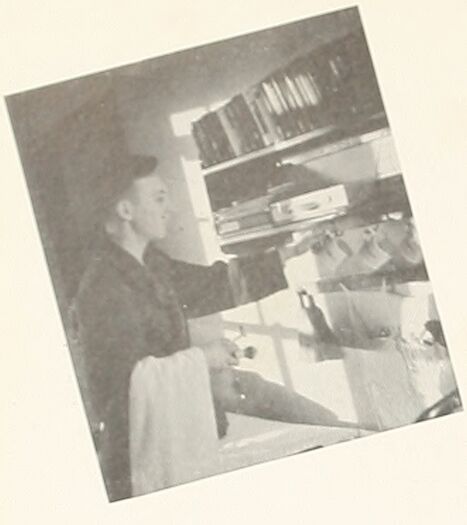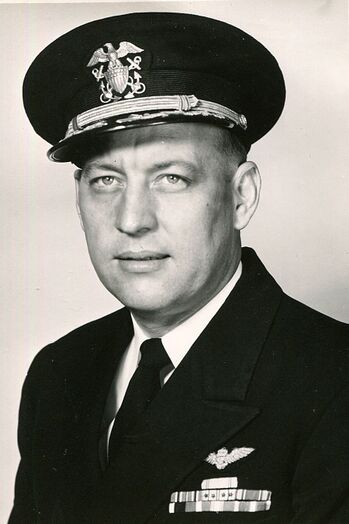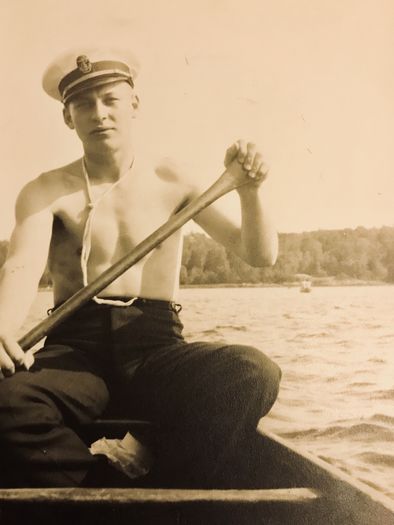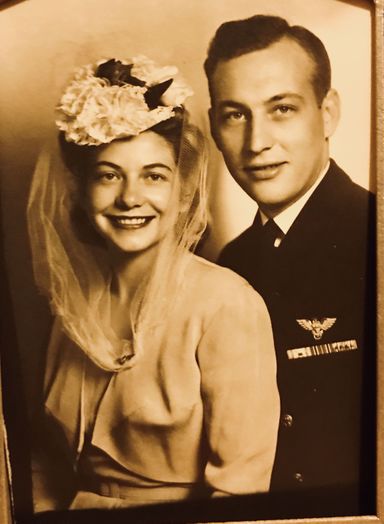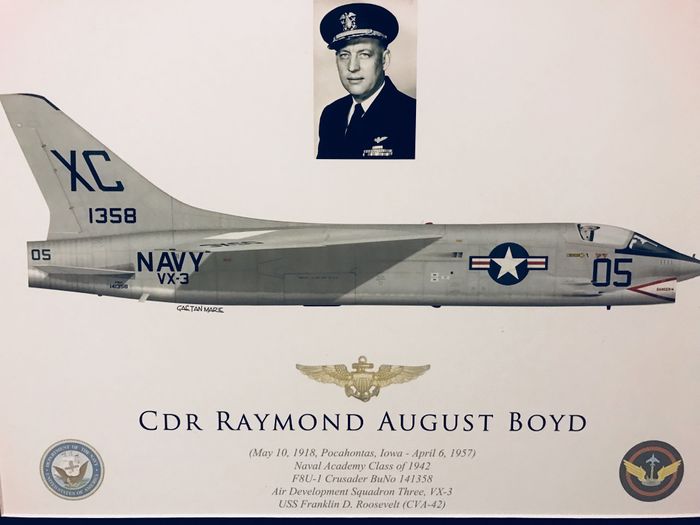RAYMOND A. BOYD, CDR, USN
Raymond Boyd '42
Lucky Bag
From the 1942 Lucky Bag:
RAYMOND A. BOYD
Pocahontas, Iowa
Ray, Tallcorn
Ray once helped lay a straight, smooth road out in Iowa. He can't figure why the Navy doesn't run like that road. His power blows come right from the shoulder, his answers flash to the hoard, and his ready grin labels him smooth. We like to think of him aboard ship, for we know that he'll be the same resolute, efficient man there that he has been here. In a word—he's fit.
Battalion Boxing; 2/c P.O.; 2 Stripes.
The Class of 1942 graduated on December 19, 1941, less than two weeks after the United States entered World War II. The class had previously been scheduled to graduate in February 1942.
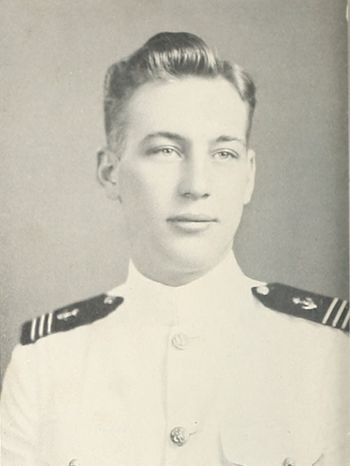
RAYMOND A. BOYD
Pocahontas, Iowa
Ray, Tallcorn
Ray once helped lay a straight, smooth road out in Iowa. He can't figure why the Navy doesn't run like that road. His power blows come right from the shoulder, his answers flash to the hoard, and his ready grin labels him smooth. We like to think of him aboard ship, for we know that he'll be the same resolute, efficient man there that he has been here. In a word—he's fit.
Battalion Boxing; 2/c P.O.; 2 Stripes.
The Class of 1942 graduated on December 19, 1941, less than two weeks after the United States entered World War II. The class had previously been scheduled to graduate in February 1942.
Loss
From Find A Grave:
My grandfather USN CDR Raymond A. Boyd was born in Pocahontas Iowa and he graduated Naval Academy class of '42. They all went straight into WWII after graduating early in December 1941 due to Pearl Harbor. He served on the USS Saratoga and with various squadrons after getting his wings after the war.
In the 1950's he entertained but turned down advanced aeronautical engineering positions from several aircraft manufacturers. In addition, he contributed design work with Grumman and Chance-Vought on various craft. He stayed in the Navy and went on to be a Commander and VX-3 F8U-1 Crusader test pilot on the carrier USS FDR.
He was on the FDR in early 1957 testing the Crusader for carrier use as part of her Mediterranean cruise. At 08:20 Saturday April 6, 1957 his F8U-1 Crusader lost power after the cat - he did not eject. He was free of the sinking plane in 14 fathoms of water a mile from the FDR but still in his harness with the parachute billowing.
Sadly both he and the helicopter crewman drowned attempting to cut him from his flight harness as they were both snarled in the chute and winch cable.
He was later pronounced dead on board the USS Wren, the ship the helicopter delivered the two men to. His body was delivered to Mayport Naval Hospital, and my grandmother was notified in person of his death almost immediately.
I have been in contact with his plane captain who was present that day but assigned to a different plane on that particular day.
He stated that CDR Boyd was very well liked among the men and treated everyone with kindness and respect and that it was a sad day on the FDR. Stefan Reuther
He was survived by his father, his wife, and four children.
Wife
His wife's obituary, from (now-defunct) ejection-history.org.uk:
24Sep08 - Eda H. Woodruff Boyd July 14, 1918 ~ September 5, 2008 Eda Helen Woodruff, daughter of Leo E. and Eda (Rohrbach) Woodruff, who preceded her in death, was born July 14, 1918 in Rexburg, Idaho.
She grew up in Blackfoot, Idaho with her nine siblings and later attended Utah State University. In 1943 she joined the U.S. Navy Waves and trained at Hunter College, New York. SP3C US NAVY; WORLD WAR II
In 1945 she married Navy Lt. Raymond A. Boyd from Pocahontas, Iowa in Pensacola, Florida. Having just graduated from Navy Flight School, he was assigned to Coronado Naval Air Station in California. His career path took them to Hawaii, Maryland, New Jersey, and Virginia.
Cdr. Boyd preceded her in death in 1957 while on active duty. She moved her family to Spokane, Washington and later to Seattle, where she finished her B.A. at the University of Washington in 1973.
As a single parent and young Navy widow, Eda raised her children with a strong emphasis on education and duty to country and family. The Spokane Valley provided the necessary wholesome and healthy environment for her young children. Seattle's close proximity to a large university provided educational opportunities for her and her daughters.
Her husband Raymond (1942), son Raymond Jr. (1973) and grandson, Samuel (2005), are all graduates of the U.S. Naval Academy.
Eda was preceded in death by one son, Ray Clinton Boyd in 1948. She is survived by four siblings and four children: Bettie A. Reuther (Terry), St. Paul, Minnesota; Eda Marie Rice (Mel), Seattle; Linda R. Landerdahl (James), Seattle; and Raymond A. Boyd Jr. (Christine), Guilford, Connecticut; seven grandchildren: Stefan Reuther (Emily), Minneapolis; Jessie Tiede (Shannon), Minneapolis; Christopher Landerdahl, Seattle; Alexis Boyd, Atlanta, Ga; Lt. Samuel Boyd, USN, Oceania, Va; Andrew Boyd, University of Connecticut; and Eda Melinda Rice, Tacoma; and one great grandson, Colin Lemmons-Reuther, Minneapolis.
Eda spent her last four years under excellent care at Pinehurst Homes in Seattle and passed away peacefully at Virginia Mason Hospital Friday evening, September 5, 2008.
Other
And in the August 1963 edition of Naval Aviation News:
Rescue Seat Now Named
Memorializes Pilot Lost at SeaThe three-pronged helicopter rescue seat, widely used in Naval Aviation today, has been officially christened. BuWeps directed the Aviation Supply Office to designate it the "Boyd Rescue Seat" in memory of Cdr. Raymond A. Boyd, USN. Cdr. Boyd lost his life at sea on April 6, 1957, following his forced ditching in an F-8 Crusader and unsuccessful rescue attempt by helicopter.
The tragedy prompted further research into rescue devices and led to the development of the three-pronged seat. Capt. R. G. Dose, then C.O. of VX-3, conceived the idea in the latter part of 1957. In February 1958, the new seat, built by HU-2, was evaluated. It proved to be far superior to the "horsecollar sling" used previously. Abraham Spector, ADR3, a helicopter crewman, was also killed in the accident while attempting to assist Cdr. Boyd into the sling. Spector was posthumously awarded the U.S. Navy and Marine Corps Medal for bravery.
Capt. Dose knew Raymond and his wife well; he had come over for dinner prior to the crash and visited again afterwards.

The "category" links below lead to lists of related Honorees; use them to explore further the service and sacrifice of alumni in Memorial Hall.
